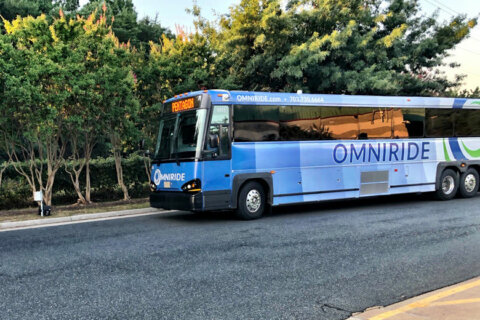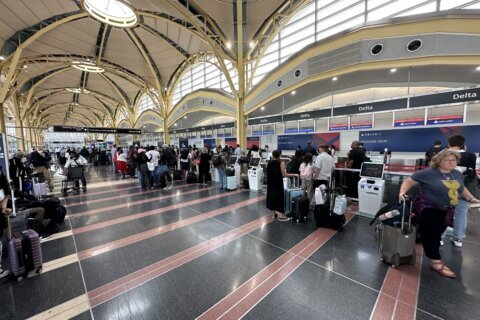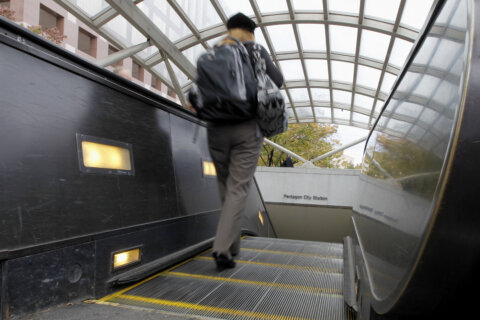WASHINGTON — Final plans for new HOV or toll lanes along more than 20 miles of Interstate 66 are due next month, but preliminary documents provide new insight into what the two toll lanes and three regular highway lanes in each direction will look like when the project is complete around 2021.
The project, which will take several homes in the corridor, will include some new park-and-ride lots in addition to the new Express Lanes between Gainesville and the Capital Beltway.
The toll lanes will operate like the 495 Express Lanes, with tolls rising and falling with traffic, and free rides for people with three or more people in the car and an E-ZPass Flex. But unlike those lanes, trucks may be allowed to use the Interstate 66 HOT lanes and there is no provision that provides a payment to the operators if the percentage of HOV traffic dramatically increases.
While the operators are expected to draw more toll payers because of the new rush-hour HOV or toll rules coming to Interstate 66 inside the Beltway next year, that project is separate.
Inside the Beltway, Virginia is running the project itself, with contractors for specific operations.
While Virginia Transportation Secretary Aubrey Layne and Gov. Terry McAuliffe had said a fully publicly funded option was a possibility outside the Beltway as well, the state is on track to award a full public concession by late October.
So far, about three teams have expressed an interest in the contract, and two have been “very active” in discussions, Layne said. McAuliffe is expected to make a decision in about two months. “Hopefully, we’ll have good news here in a couple months, ” he said.
The choice for the 50-year contract will be based on technical proposals due in early September and financial proposals due in early October. The financial proposals can include up to $946 million in private activity bonds, a request for up to $800 million in low-interest federal loans and up to $600 million in funding from Virginia.
“Plus, let’s be honest, this gave us a lot of leverage,” McAuliffe chimed in.
Previously, Virginia had wound up on “the bad side of negotiating deals,” McAuliffe said. But this time was different, he said.
“I mean, I don’t blame the companies who did those other deals, they out-negotiated the commonwealth of Virginia … by doing the framework the way we set it up, all the leverage was on our side for the best deal,” he said.
The construction could be done in phases as permits are approved, but Layne said the entire stretch will open at once, no later than 2022.
Construction would begin by July 2017, with some early work beginning before that date on design public hearings, designs for changes to Metro facilities and environmental permits or utility relocation.
As part of construction, the private companies expected to get the contract to design, build, operate and maintain the lanes may need to demolish and rebuild the pedestrian bridges over I-66 that provide access to the Vienna and Dunn Loring Metro stations. Other work could impact Metro power substations in the area, and any changes will be the responsibility of the developer.
VDOT also requires the developer to maintain the new active traffic management system along I-66 “for as long as practical,” with some pieces of the system remaining functional throughout construction.
The developer will fund for transit options like commuter bus routes that would give drivers an option besides paying a toll. The exact projects funded are expected to be left to a to-be-determined regional group in Northern Virginia like the Northern Virginia Transportation Authority or the Northern Virginia Transportation Commission.
While it will not be part of the plans, an overall goal of the project is to provide flexibility to add dedicated transit lanes or rails to the median of I-66 at some point in the future.
In the Express Lanes, a comprehensive agreement outlines the free rides for high-occupancy vehicles with an E-ZPass Flex, transit buses, school buses and motorcycles, as well as how those riding without an E-ZPass can be charged and what happens if they do not pay.
Trucks would be allowed in the lanes at rates of at least five times the toll to other vehicles during peak periods, and at least three times the toll to other vehicles at other times.
There are provisions that allow for the temporary suspension of tolls in the event of a serious crash in the regular lanes or other emergencies.
The lane operators will pay for both regular Virginia State Police patrols of the lanes, and any extra troopers for HOV enforcement or construction work.
Baseline charges for the regular patrols range from $2.3 million for 2022 to $6.8 million in 2066.
For drivers, if Virginia does not provide E-ZPasses or similar transponders, the operators can charge purchase fees up to 110 percent of the cost of the transponder and administrative fees up to $24 per year.
The operators are required to limit the impact on the 495 Express Lanes, and to pay fines during construction any time that lanes are closed without permission for more than five minutes.
Any unpermitted closure beyond that costs $8,000 for the sixth minute plus $1,500 for each additional minute on I-66, I-495, Route 50, Route 28 and ramps.
There are smaller fines for similar closures on other roads, and separate penalties over the course of the contract for failing to meet requirements.
After the contract is over in 2066, Virginia gets the lanes back. The contract provides that the state can either leave the tolling system in place or have the developers demolish it so that the lanes can revert to standard HOV lanes.







